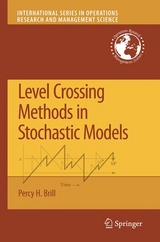Level Crossing Methods in Stochastic Models
Springer-Verlag New York Inc.
978-0-387-09420-5 (ISBN)
- Titel erscheint in neuer Auflage
- Artikel merken
From 1972 to 1974, I was working on a PhD thesis entitled Multiple Server Queues with Service Time Depending on Waiting Time.The method of analysis was the embedded Markov chain technique, described in the papers [82] and [77]. My analysis involved lengthy, tedious deri- tions of systems of integral equations for the probability density function (pdf) of the waiting time. After pondering for many months whether there might be a faster, easier way to derive the integral equations, I ?nally discovered the basic theorems for such a method in August, 1974. The theorems establish a connection between sample-path level-crossing rates of the virtual wait process and the pdf of the waiting time. This connection was not found anywhere else in the literature at the time. I immediately developed a comprehensive new methodology for deriving the integral equations based on these theorems, and called it system point theory. (Subsequently it was called system point method,or system point level crossing method: SPLC or simply LC.) I rewrote the entire PhD thesis from November 1974 to March 1975, using LC to reach solutions. The new thesis was called System Point Theory in Exponential Queues.
On June 12, 1975 I presented an invited talk on the new methodology at the Fifth Conference on Stochastic Processes and their Applications at the University of Maryland. Many queueing theorists were present.
Percy Brill holds a BSc in mathematics and physics from Carleton University, Canada, an MA in mathematical statistics from Columbia University, USA, and a PhD in industrial engineering with a minor in mathematics from the University of Toronto, Canada. He has held an NSERC (Natural Sciences and Engineering Research Council of Canada) grant continuously for 26 years. He served as a consultant for an NSF (National Science Foundation, USA) grant for 4 years. In addition to his academic career, he worked in industry for 12 years as a research scientist, statistical programmer and data processing consultant. He is presently a Professor Emeritus in the Departments of Management Science and Mathematics & Statistics at the University of Windsor, Canada. He has published over 99 articles in refereed journals, conference Proceedings, books and technical reports. In addition, he has presented over 110 talks and seminars at conferences, universities and professional society meetings. He served as president of the Southeastern-Michigan chapter of INFORMS from 1994 to 1996. He is a former associate editor of the journal INFOR. He received the CanQueue 2000 Award of Distinction in recognition of his work in Applied Probability especially in the area of Level Crossing Techniques, at the Canadian queueing conference held at the University of Western Ontario, Canada in September 2000. His research interests include: level crossing theory and methods, applied probability, stochastic processes, stochastic modeling, queueing theory, renewal theory, applied mathematics, and nonparametric statistical inference.
Origin Of Level Crossing Method.- Sample Path And System Point.- M/G/1 Queues And Variants.- M/M/C Queues.- G/M/c Queues.- Dams and Inventories.- Multi-Dimensional Models.- Embedded Level Crossing Method.- Level Crossing Estimation.- Additional Applications.
| Reihe/Serie | International Series in Operations Research Management Science ; 123 |
|---|---|
| Zusatzinfo | 6 black & white tables, biography |
| Verlagsort | New York, NY |
| Sprache | englisch |
| Maße | 155 x 235 mm |
| Gewicht | 920 g |
| Themenwelt | Mathematik / Informatik ► Mathematik ► Angewandte Mathematik |
| Mathematik / Informatik ► Mathematik ► Wahrscheinlichkeit / Kombinatorik | |
| ISBN-10 | 0-387-09420-2 / 0387094202 |
| ISBN-13 | 978-0-387-09420-5 / 9780387094205 |
| Zustand | Neuware |
| Informationen gemäß Produktsicherheitsverordnung (GPSR) | |
| Haben Sie eine Frage zum Produkt? |
aus dem Bereich





